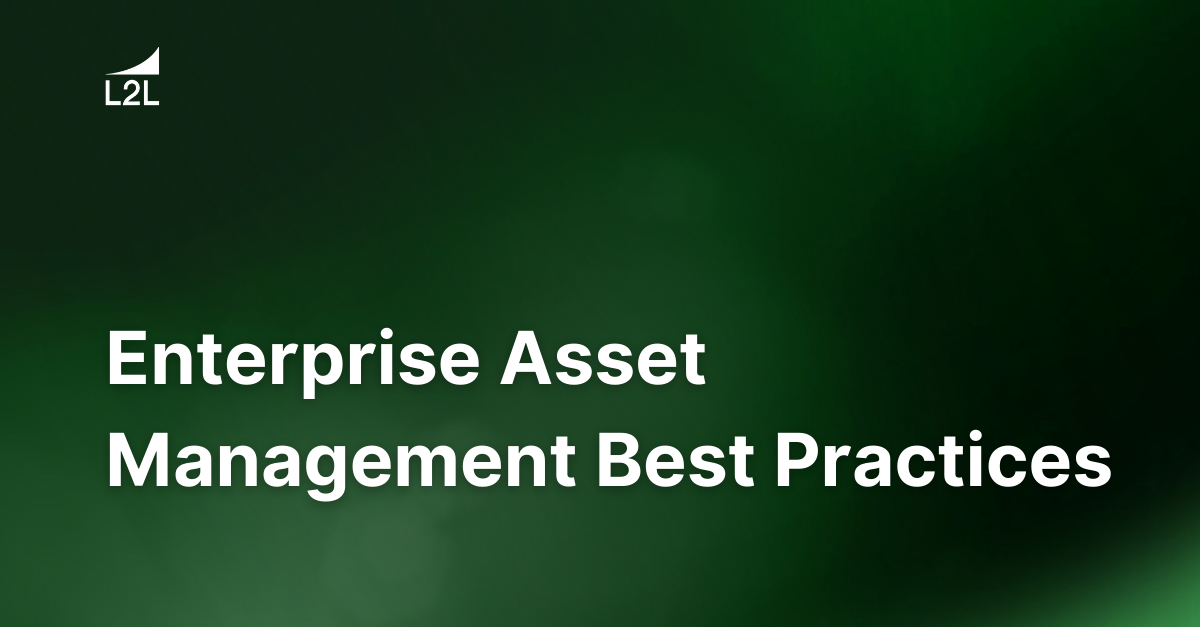
Enterprise Asset Management Best Practices
Enterprise asset management, or EAM, is one of the most accessible opportunities for taking your manufacturing organization to the next level. And Modern EAM software is fast, user-friendly and rich in the solutions your teams are craving.
If you'd like to learn more about the benefits of Modern EAM and where to get started along with digging into best practices, feel free to check out our Modern EAM Guide.
The power of enterprise asset management
Before we jump into best practices, let’s take a look at EAM itself.
Enterprise asset management is your all-in-one approach to maintaining, supporting and overseeing both digital and physical assets from across your organization. That’s how it should be, anyway. The reality is that EAM has lots of moving parts, which, unfortunately, has often been translated into too many different tools and solutions.
Luckily, Modern EAM software is here to change that.
By combining all the elements of enterprise asset management into one user-friendly platform, EAM software puts you at the heart of the asset lifecycle. You’ll see value in numerous ways, including:
- Insight into asset performance.
- Automated preventive maintenance.
- Improved asset reliability.
- Simplified asset tracking.
- Solutions addressing digital and physical assets.
- Better utilization of asset data.
- Clearer, more useful analytics options.
- Streamlined communication among predictive maintenance and production teams.
Do those benefits sound too good to be true? Well, they’re not — but there is a catch. To be as effective as possible, EAM software, like just about everything in manufacturing, must be implemented with best practices in mind. These approaches act as a guardrail, keeping you firmly within the realm of high ROI.
Enterprise asset management software best practices come in three basic flavors:
- Transparency and accountability.
- Real-time mobile access.
- Quick and easy deployment.
Let’s dive into each one.
Enterprise asset management: Transparency & accountability
Transparency and accountability are, in many ways, the foundation upon which all your successes are built. They’re the key to smooth processes, improved asset performance and effective communication.
Unfortunately, they’re also infamously difficult to achieve.
With modern asset management software, that difficulty is a thing of the past. Goodbye, hidden problems and convoluted asset lifecycle tracking — hello, efficiency.
Transparency
In contrast to traditional EAM solutions, modern asset management solutions give you access to the truth as it relates to asset performance, inventory management, personnel productivity, asset tracking and more. Whether you’re across the building or across the world, you’ll always have visibility into every process on your factory floor. You’ll see the whole picture, from resource allocation to real-time issue identification. The key is to ensure you’re utilizing a modern system, built for today’s modern factories that require new levels of transparency.
Here are a few ways that modern systems foster transparency:
- Provide EAM system access to everyone on the plant floor: This gives all workers an active role in reporting, analysis, asset data collection and utilizing that data to solve problems and impact the bottom line.
- Discourage procrastination: Modern EAM software makes it easy to enter data into the system in real-time, while in the maintenance task (instead of rushed and error-filled data entry at the end of the shift, day or even week.).
- Focus: With Modern EAM software, you’re tuned in to every step of the asset lifecycle. Use data to focus in on the problems that matter most to solve. Then you’ll know that you and your teams are realizing measurable improvement in the things that matter, such as production throughput of quality products.
Accountability
The best part about transparency is that it is, in itself, a best practice for improving accountability. When you know where people and resources need to be, they’re more likely to actually be there. That leads to all kinds of other benefits, like more effective asset management and better resource allocation — because when you can actually see problems, they’re a whole lot easier to solve.
Enterprise asset management: Real-time mobile access
These days, real-time data is like currency. You need to have access to relevant, up-to-date information no matter where you go — and the right system digitizes the EAM best practices that you want the workforce to follow.
Real-time mobile access gives you instant insight into asset tracking, asset optimization, preventive maintenance and more — all at the tap of a screen. It provides the most important details, from quality history to repair schedules, and helps keep workers at work instead of hunting down some small but vital piece of asset information. That’s good news for productivity, but it’s also a great way to get accurate information about the effectiveness of preventive maintenance and its impact on asset reliability.
Here are a couple of best practices to help you make it happen:
- Make mobile devices the standard: Make sure everyone has mobile access to the data (such as equipment repair history, bill of materials, and spare parts) they need to make quick and accurate decisions about maintenance execution, operational assets and more while in the task.
- Avoid the quick-fix temptation: With real-time mobile access, you can always get the data you need — which means there are no excuses for quick fixes that don’t take the right info into account or don’t address an especially critical problem. Instead, make sure your workers take advantage of the wealth of data at their fingertips.
Enterprise asset management: Quick & easy deployment
One of the stumbling blocks of “old-fashioned EAM” is that, despite its theoretical benefits, it wasn’t and still isn’t easy to deploy. If this sounds familiar, it’s for good reason: Lean manufacturing had many of the same issues — which is why we took the good stuff, threw out the bad and created an entirely new approach to efficiency and waste reduction.
Modern EAM software is based in the cloud. That means it’s quick and easy to deploy and can always be configured to your factory’s needs. No extended customization is necessary — which means you can deploy and start seeing ROI in just weeks, not months or years.
To make deployment even quicker and easier, check out these best practices:
- Make cloud partners part of your world: You won’t need consultants to get your EAM system up and running. However, it is important to integrate cloud solution partners into your IT and OT teams, enabling you to deploy and start seeing ROI from the solutions you need much more quickly.
- Create priorities: Which elements of asset management need to be at the top of your list? Is it preventive maintenance? Inventory management? Maybe you’re interested in immediately improving asset tracking or asset reliability. Whatever your priorities, make sure you take advantage of stress-free deployment to start seeing benefits in the most important areas of your operation.
Put best practices to work
There may be three flavors of enterprise asset management best practices, but when you put them together, they create something way more powerful. That’s right: For best results, these elements should be interconnected, creating a set of standardized practices that will drive operational improvement over time. They’re the building blocks for high ROI, improved communication, better data management and analysis, simplified workflows, more reliable processes and unbeatable asset management.
Of course, these best practices and benefits are nothing without the modern EAM software that will help you get there. Cloud-based, user-friendly and totally mobile, every EAM system is designed to help manufacturers like you live the dream.
The good news is that you’re not alone when choosing the EAM solution that will simplify your world. We’re here to help with all the resources, advice and, yes, Modern EAM software to get you up and running. We can also help you put these and other enterprise asset management best practices into action as you become more comfortable with the solution and start seeing that ROI.
Plus, we practice what we preach. Our eBook, “How to Reduce Operational Costs with Modern EAM,” combines our industry expertise with our extensive EAM experience to show you exactly what we mean. Download it as a reference, a guide or even as inspiration.
If you’re ready to put enterprise asset management to work in your manufacturing organization, contact us today to book a demo.
Revisions
Original version: 18 July 2024
Written by: Evelyn DuJack
Reviewed by: Daan Assen
Please read our editorial process for more information
Related Posts
Subscribe to Our Blog
We won't spam you, we promise. Only informative stuff about manufacturing, that's all.

